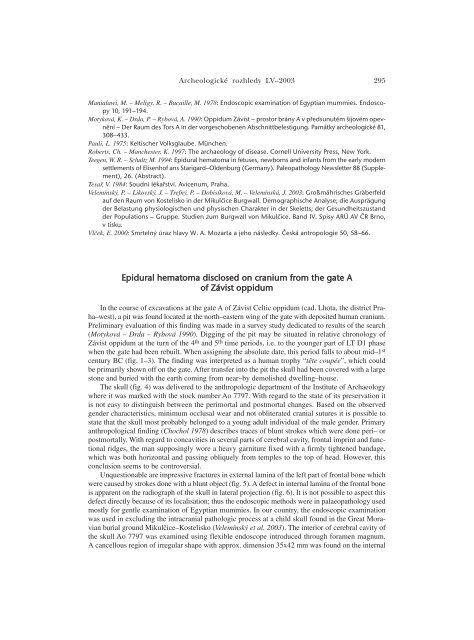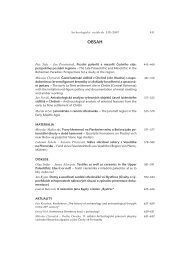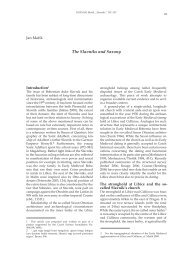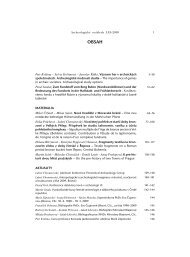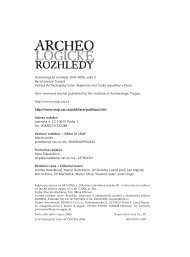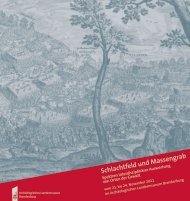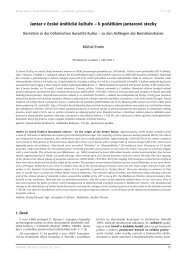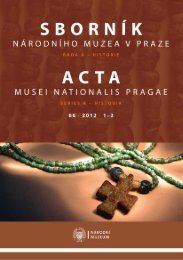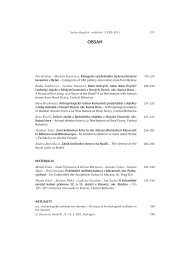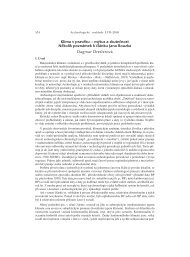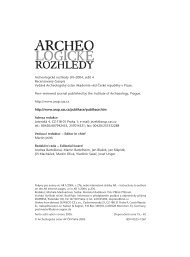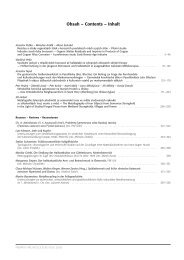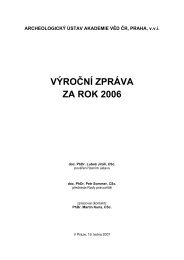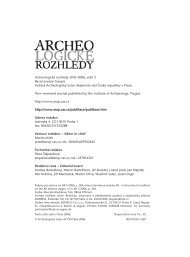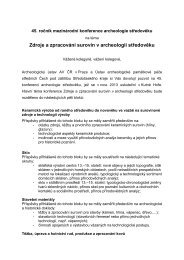2003_2 - Archeologický ústav AV ČR
2003_2 - Archeologický ústav AV ČR
2003_2 - Archeologický ústav AV ČR
Create successful ePaper yourself
Turn your PDF publications into a flip-book with our unique Google optimized e-Paper software.
Archeologické rozhledy LV–<strong>2003</strong> 295Manialawi, M. – Meligy, R. – Bucaille, M. 1978: Endoscopic examination of Egyptian mummies. Endoscopy10, 191–194.Motyková, K. – Drda, P. – Rybová, A. 1990: Oppidum Závist – prostor brány A v předsunutém šíjovém opevnění– Der Raum des Tors A in der vorgeschobenen Abschnittbefestigung. Památky archeologické 81,308–433.Pauli, L. 1975: Keltischer Volksglaube. München.Roberts, Ch. – Manchester, K. 1997: The archaeology of disease. Cornell University Press, New York.Teegen, W. R. – Schultz M. 1994: Epidural hematoma in fetuses, newborns and infants from the early modernsettlements of Elisenhof ans Starigard–Oldenburg (Germany). Paleopathology Newsletter 88 (Supplement),26. (Abstract).Tesař, V. 1984: Soudní lékařství. Avicenum, Praha.Velemínský, P. – Likovský, J. – Trefný, P. – Dobisíková, M. – Velemínská, J. <strong>2003</strong>: Großmährisches Gräberfeldauf den Raum von Kostelisko in der Mikulčice Burgwall. Demographische Analyse; die Ausprägungder Belastung physiologischen und physischen Charakter in der Skeletts; der Gesundheitszustandder Populations – Gruppe. Studien zum Burgwall von Mikulčice. Band IV. Spisy ARÚ <strong>AV</strong> <strong>ČR</strong> Brno,v tisku.Vlček, E. 2000: Smrtelný úraz hlavy W. A. Mozarta a jeho následky. Česká antropologie 50, 58–66.Epidural hematoma disclosed on cranium from the gate Aof Závist oppidumIn the course of excavations at the gate A of Závist Celtic oppidum (cad. Lhota, the district Praha–west),a pit was found located at the north–eastern wing of the gate with deposited human cranium.Preliminary evaluation of this finding was made in a survey study dedicated to results of the search(Motyková – Drda – Rybová 1990). Digging of the pit may be situated in relative chronology ofZávist oppidum at the turn of the 4 th and 5 th time periods, i.e. to the younger part of LT D1 phasewhen the gate had been rebuilt. When assigning the absolute date, this period falls to about mid–1 stcentury BC (fig. 1–3). The finding was interpreted as a human trophy “tête coupée”, which couldbe primarily shown off on the gate. After transfer into the pit the skull had been covered with a largestone and buried with the earth coming from near–by demolished dwelling–house.The skull (fig. 4) was delivered to the anthropologic department of the Institute of Archaeologywhere it was marked with the stock number Ao 7797. With regard to the state of its preservation itis not easy to distinguish between the perimortal and postmortal changes. Based on the observedgender characteristics, minimum occlusal wear and not obliterated cranial sutures it is possible tostate that the skull most probably belonged to a young adult individual of the male gender. Primaryanthropological finding (Chochol 1978) describes traces of blunt strokes which were done peri– orpostmortally. With regard to concavities in several parts of cerebral cavity, frontal imprint and functionalridges, the man supposingly wore a heavy garniture fixed with a firmly tightened bandage,which was both horizontal and passing obliquely from temples to the top of head. However, thisconclusion seems to be controversial.Unquestionable are impressive fractures in external lamina of the left part of frontal bone whichwere caused by strokes done with a blunt object (fig. 5). A defect in internal lamina of the frontal boneis apparent on the radiograph of the skull in lateral projection (fig. 6). It is not possible to aspect thisdefect directly because of its localisation; thus the endoscopic methods were in palaeopathology usedmostly for gentle examination of Egyptian mummies. In our country, the endoscopic examinationwas used in excluding the intracranial pathologic process at a child skull found in the Great Moravianburial ground Mikulčice–Kostelisko (Velemínský et al. <strong>2003</strong>). The interior of cerebral cavity ofthe skull Ao 7797 was examined using flexible endoscope introduced through foramen magnum.A cancellous region of irregular shape with approx. dimension 35x42 mm was found on the internal


